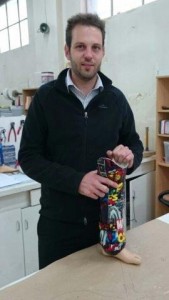Patrick McQualter, Prosthetist (Orthodaedic Appliances)

What is your qualification and why did you choose Prosthetics as your post-school career pathway?
I completed a Bachelor of Prosthetics and Orthotics at La Trobe University in 2005. I chose this field as I enjoyed subjects like woodwork and graphics at school and also wanted to undertake a health related course because I’ve always gained satisfaction helping others. Prosthetics allows me to use my hands, tap into my creative side while also helping to improve the quality of life for others.
Would you recommend this as a career to young people currently thinking about their post-school pathway?
After graduating from University I worked as a Prosthetist in Sydney for two and a half years. I then returned to Melbourne and have been working at Orthopaedic Appliances in Fitzroy (Melbourne) for the past seven years. As was the case with me, future students have to prepare for the possibility of moving interstate for graduate employment. One of the advantages of the program is practical placements, something that allowed me to explore a variety of options and ‘learn on the job’ with a range of organisations. My employer Orthopaedic Appliances offers placements to students as we all believe it is important to support both La Trobe University and industry members of the future.
Describe your clients?
I work with upper and lower limb difference clients of all ages. My youngest patient is a one year old and my oldest is 98, who had his foot amputated when he was just three.
What makes working with children enjoyable?
Kids always have such a positive attitude no matter what they have been through, and it never ceases to amaze me what they are able to achieve! I’m privileged to be a big part of their lives and watch them grow from kids into adults. Knowing that I’ve made a difference in the life of a child or young person is very rewarding. I also love and laugh at the very funny things kids say and do during appointments!
How does working with children differ from working with adult amputees?
The main difference between working with children compared to adults is that kids are still growing. This means more frequent appointments and new prostheses. You are also working with, and often communicating through, the parents rather than the one-on-one communications you have with adult patients. In general children and young people are also very active and therefore tend to break their prostheses a lot quicker than adults! Working with children does pose some challenges. Because of their size and the fact they are still growing we do have limitations in terms of the componentry available to children and reduced space below the residual limb to fit prosthetic feet. However, as children grow these limitations generally diminish over time.
What role does a Prosthetist play in supporting children with limb differences?
As a Prosthetist you become more than just a limb maker. As we see these kids and their parents so often we are also there to provide emotional support and advice. We can also assist in connecting children and their parents with other kids or adults with similar congenital or acquired limb differences. Often I will arrange appointments so that kids with similar limb differences can attend at the same time as this allows them to meet, share stories and relate to someone else who is in the same situation.
How do Prosthetists and Technicians work together to build a prosthetic limb?
The first stage in fitting a child with a prosthesis is to measure them up and take a plaster cast of their residual limb. The Prosthetist will then modify the cast and prepare it for the manufacturing stage. The prosthetic socket will be laminated by one of the five technicians we have at Orthopaedic Appliances. Any components, including knees and feet, will be ordered in from suppliers. The Prosthetist will then connect the socket to the components, align the prosthesis and fit it to the patient. A second cosmetic lamination is then often required before the child takes the prosthesis home. Many children will choose their favourite cartoon character, football team or artwork to personalise their prosthesis – so we support kids to bring their creative imaginations to life!
How do you assist children who experience fears or worries during appointments?
I try to have fun with the kids during their appointments and reassure them that they have nothing to be scared about. If all else fails the TV is a good distraction and lollies are a good bribe!
What current developments in the field of prosthetics excite you?
The constant advancements in microprocessor controlled prosthetic knees and ankles is very exciting, which will hopefully be more accessible to children in the near future.
Why is early-intervention and the Limbs 4 Kids program beneficial?
I think the work that Limbs 4 Kids does is of great value to all of my young patients and their families. The importance of early-intervention cannot be understated as it allows kids to know they are not alone, enables them to share experiences and learn tips from each other.
Is there any critical information or advice that you give to all children using a prosthesis (and/or their parents)?
My main advice to parents is “Let them be kids!” Parents shouldn’t be afraid of their child breaking their prosthesis as we can always make another one.
